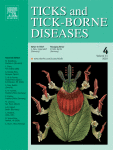Ver ítem
- xmlui.general.dspace_homeCentros Regionales y EEAsCentro Regional Santa FeEEA RafaelaArtículos científicosxmlui.ArtifactBrowser.ItemViewer.trail
- Inicio
- Centros Regionales y EEAs
- Centro Regional Santa Fe
- EEA Rafaela
- Artículos científicos
- Ver ítem
Sensitivity of Anaplasma marginale genotypes to oxytetracycline assessed by analyzing the msp1α gene in experimentally infected cattle
Resumen
The aim of this study was to evaluate the influence of the long-acting oxytetracycline (OTC) treatment on A. marginale genotypes of the isolate S1P, by analyzing the msp1α genotype based on a microsatellite (ms) and tandem repeat sequences (TRS) located at the 5´ end of the gene. DNA samples were obtained from a longitudinal study of chemosterilization; 10 2-year-old steers were experimentally infected with blood from a splenectomized calf inoculated with
[ver mas...]
The aim of this study was to evaluate the influence of the long-acting oxytetracycline (OTC) treatment on A. marginale genotypes of the isolate S1P, by analyzing the msp1α genotype based on a microsatellite (ms) and tandem repeat sequences (TRS) located at the 5´ end of the gene. DNA samples were obtained from a longitudinal study of chemosterilization; 10 2-year-old steers were experimentally infected with blood from a splenectomized calf inoculated with the A. marginale isolate S1P. All the steers had received a first dose of 20 mg kg−1 OTC to treat acute disease, and once recovered all steers received a sterilizing treatment based on three doses of 20 mg kg−1 OTC 7 days apart. Blood from two steers not sterilized by the treatment was inoculated into two splenectomized calves (receptors) 104 days after treatment. DNA samples (S) used for msp1α amplification were obtained from i) the donor calf (S0), ii) 10 steers during acute disease (S1), after the first antibiotic treatment (S2), and after the chemosterilization procedure (S3 and S4), and iii) two receptor calves (S5). Thirty clones from the donor calf and at least 5 clones from the other DNA samples were analyzed. The genotype E/αββββГ msp1α identified in the donor calf and steers, before OTC treatment, was not detected either in steers that continued infected after the sterilizing treatment or in the receptor calves, in which only genotype C/EϕFF msp1α was observed. These results highlight the existence of A. marginale genotypes with different sensitivity to OTC and the importance of other variables to successfully sterilize the carriers.
[Cerrar]

Fuente
Ticks and Tick-borne Diseases 12 (5) : 101787 (September 2021)
Fecha
2021-09
Editorial
Elsevier
ISSN
1877-959X
Formato
pdf
Tipo de documento
artículo
Palabras Claves
Derechos de acceso
Embargado
 Excepto donde se diga explicitamente, este item se publica bajo la siguiente descripción: Creative Commons Attribution-NonCommercial-ShareAlike 2.5 Unported (CC BY-NC-SA 2.5)
Excepto donde se diga explicitamente, este item se publica bajo la siguiente descripción: Creative Commons Attribution-NonCommercial-ShareAlike 2.5 Unported (CC BY-NC-SA 2.5)

